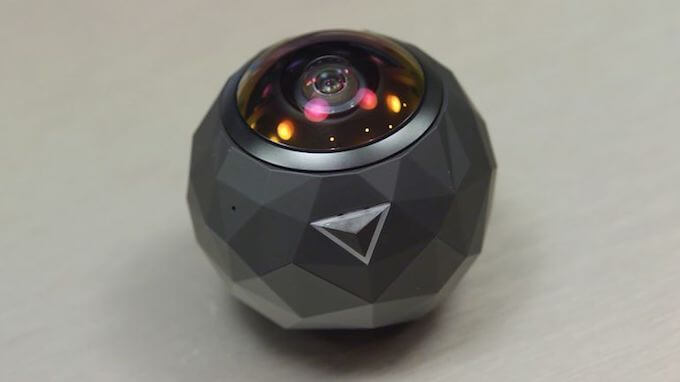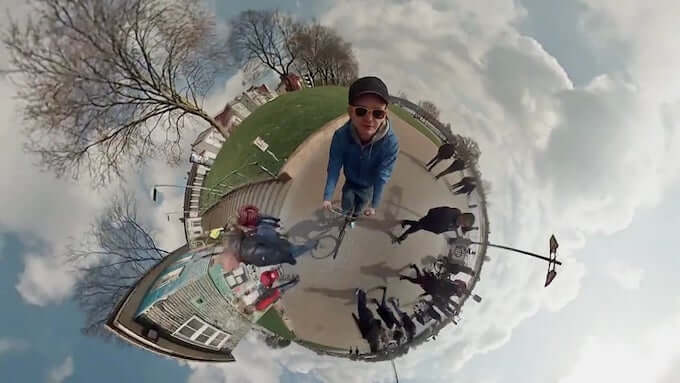Making 360 videos is more convenient and easy. You can now get rid of all the standard video rules from your head while shooting. Although resolution is a downside currently, the pros in using a 360 video camera like the 360Fly 4k outweigh the cons.
A typical 360 degrees video in VR format lets you look in all directions (up, down, left, right, and behind). This means almost life-like experience on your screen. Indeed there are a few things you should know before you start making 360 videos, so that you don’t miss out on the fun stuff.
You Need To Know About 360 degrees cameras
Not all the 360 degrees video cameras offer you the same output. There are already a wide variety of options available in the market. Choosing the right one for you is the first step to get through.
From a simple google search for 360 degrees cameras you can see that you can spend anywhere between $200 and $60,000 for a LG 360 Cam and Nokia Ozo Camera respectively. Generally, higher the price you can expect better resolution and ability to shoot stereoscopic videos (for VR).
Note that these models differ from each other in terms of viewing angle also. Though some cameras have the name 360 in them, that doesn’t mean they have 360 degrees viewing range. For example, the 360Fly 4k camera we wrote about in our previous post has a view angle of 360×240. This means it has a 360 degree horizontal and 240 degrees vertical viewing range.
However, the missing angle is compensated with graphics. Instead, you can get a complete spherical view if you attach 6 GoPro cameras on GoPro’s Omni or a third party rig.
Monoscopic Vs Stereoscopic Cameras – Short Intro
Like mentioned earlier, the higher price in cameras like Nokia Ozo is due to the ability to shoot stereoscopic videos. Although monoscopic videos are the most common ones that you find in Facebook and Youtube, these have absolutely no depth perception.
All you can do with these videos is move around in the screen with it being flat. Virtual Reality can’t be realized with such non-immersive content. So we have the stereoscopic cameras.
These videos are shot using two lenses with each covering one field of vision. You can enjoy such 360 degrees spherical videos using any of these high-end virtual reality devices.
You can learn a lot more about stereoscopic videos and their differences from monoscopic videos from our previous article.
Monoscopic Vs Stereoscopic Videos: Which 360 Degrees Videos Should You Shoot?
All the 360 videos you are watching from YouTube and Facebook are monoscopic… Stereoscopic videos add a coolness factors to videos, but in some cases..
Based on Difficulty Level
In this article we are only going to deal with monoscopic 360 cameras. Based on ease of usage (a.k.a difficulty level) these 360 degrees cameras can be divided into three groups: Beginner, Advanced and Professional
Beginner: With this category of cameras you can point and shoot and immediately share. The Samsung Gear 360, Ricoh Theta S and LG 360 Cam come are some of the reasonably well-rated cameras of this category.
The best part is anyone can start making 360 videos with these because the stitching is done automatically without any need for editing.
Advanced: The Kodak Pixpro SP360 4K Dual Pack Pro (priced at $900) consists of two PixPro cameras mounted on a cage. Two cameras means you get the output from 2 different sources and hence have to stich them together.
Professional: If you are increasing the number of cameras caged, the more stitching you’ll need to do. So is the case with Freedom 360. The plus here is, with mounts like these you eliminate the chance for any blind spots. And you have the freedom to use any of your existing GoPro (Hero4/Hero3+/Hero3).
Convenient and Compact
Ricoh Theta S and other beginner level 360 cameras are only compact enough to fit in your pockets. And models like the Freedom360 rig or Pixpro require some setup time and dedicated space. The Theta comes with 8GB of internal storage on board and a built in battery. And as the number of cameras being used goes up so does the hassle to charge multiple batteries and tracking of multiple SD cards.
Importance of Stitch Line While Making 360 Videos
It is hard to visualize how your shot will look like in 360 before you shoot. This particularly goes with the light disturbances and image balancing between the different cameras and the location of stitch line.
Talking of stitch line, it is the point where video from each lenses meets the other and completes the full sphere. Beginner category cameras like Ricoh Theta stitch internally in real time. This internal stitching is seamless and even the actual camera is stitched out of the shot.
Stitching is complicated if not frustrating
While dealing with multiple cameras (like Pixpro or Freedom360 rig) you’ll have to manually stitch your footage from all sources.
Kodak’s free editing software uses audio as base to match clips with the click of a button. Though the process may seem straightforward there are chances of objects and people disappearing near the stitch line. You’ll then have to tweak this manually added to this the editing is limited to basics.
Similar other software like the Kolor offers you better control over stitching and quality but is priced heavily at around $650 for pro version.
Resolution is not that good in 360 videos
360 camera companies continuously advertise maximum resolution of flat RAW images. But once they are rendered to 360, the resolution turns worse.
For example, the 360Fly 4k boasts a resolution of 2880 x 2880 pixels but in “headset mode” it looks more like 720p and the edges are blurry. Same goes for the others like the Kodak and GoPro.
Video quality when sharing
YouTube, Facebook and other 360 video players compress video files while being uploaded. Hence the starting resolution matters the most. The better the starting resolution, the better the output after getting compressed.
Viewing quality matters too
If you play these 360 videos at the default resolution, you might not really like them. It is hence suggested to set the player setting to the maximum possible resolution. If you are watching some 360 videos in YouTube, choose the 4k quality (if allowed). In Facebook, make sure you watch them in HD mode.
Imperfections will be part of your journey
Shooting 360 videos may end up going wrong sometimes even though you do everything right. Currently the best method you can follow is the trail and error method till you hit the sweet spots. Anyways, rapid developments is going on in terms of 360 degrees cameras and we can expect more product iterations and better competitors moving in to this market. It’s up to you to wait it out till a ground breaking product turns everything around or jumping in head first and starting making 360 videos recordings.


